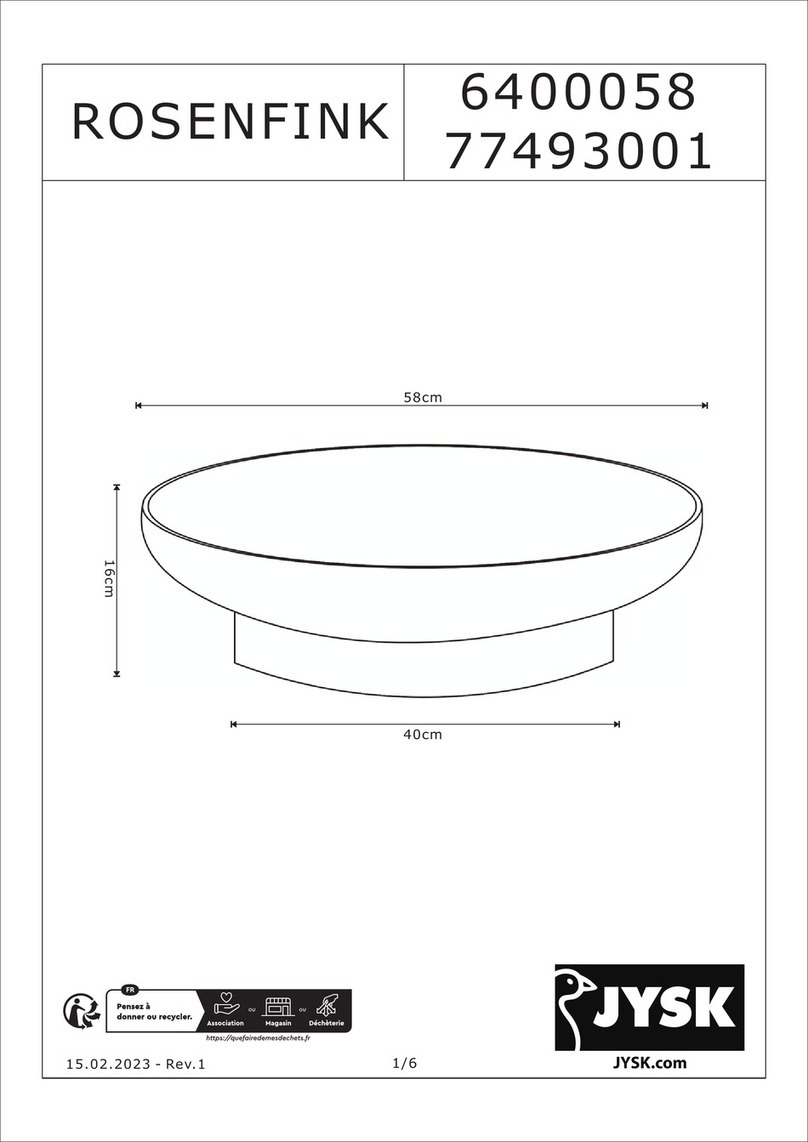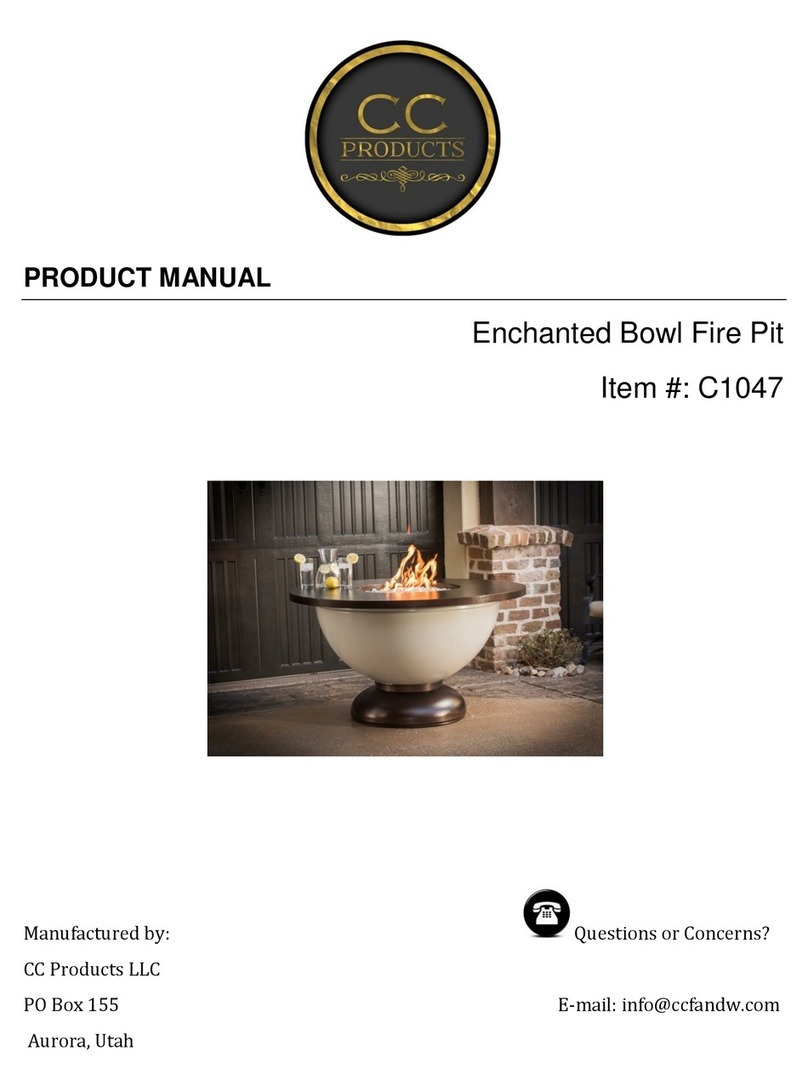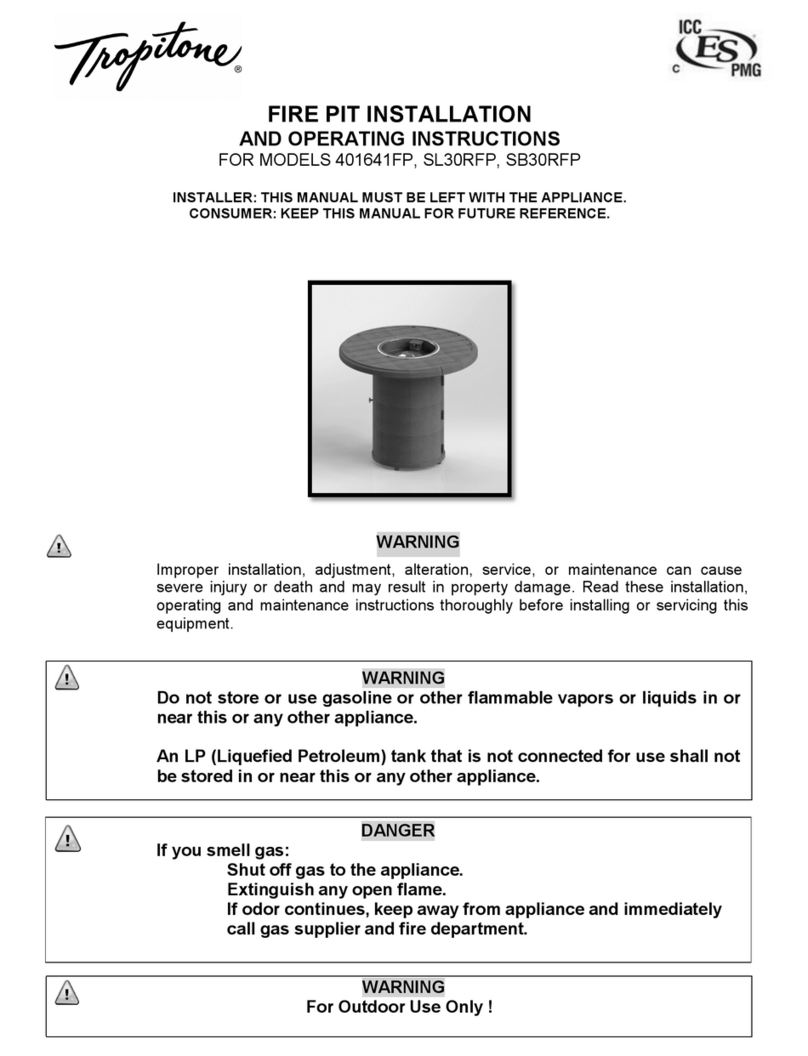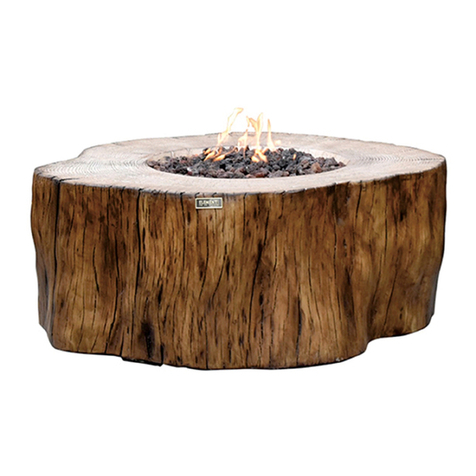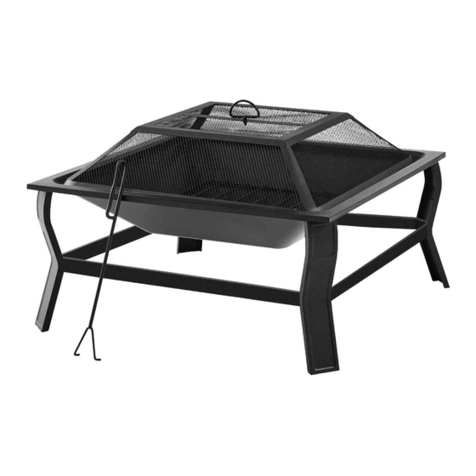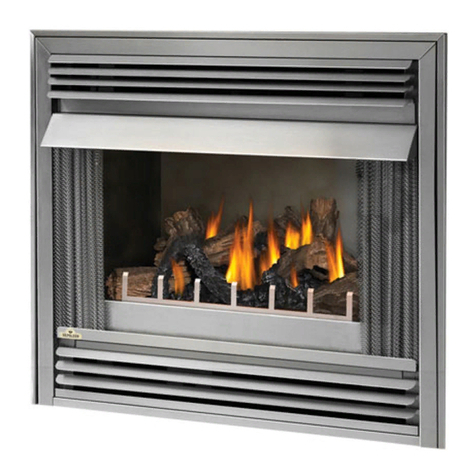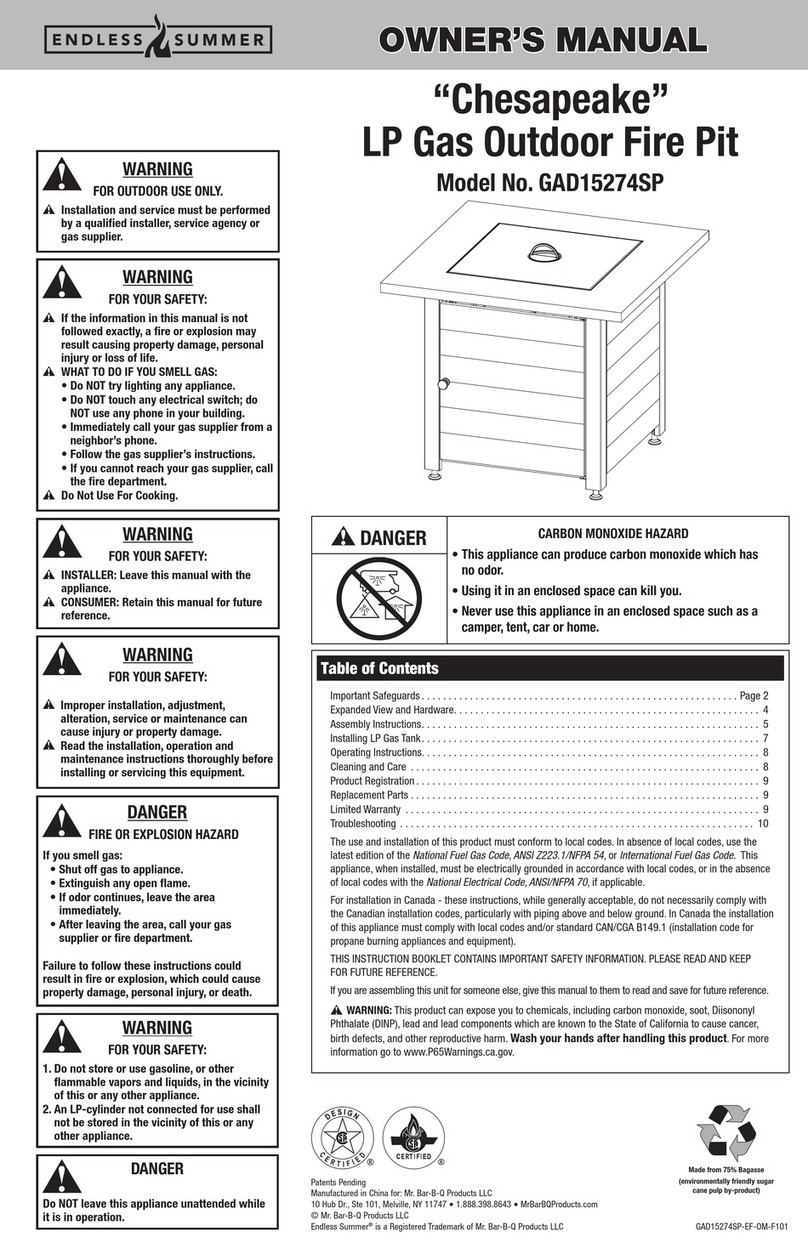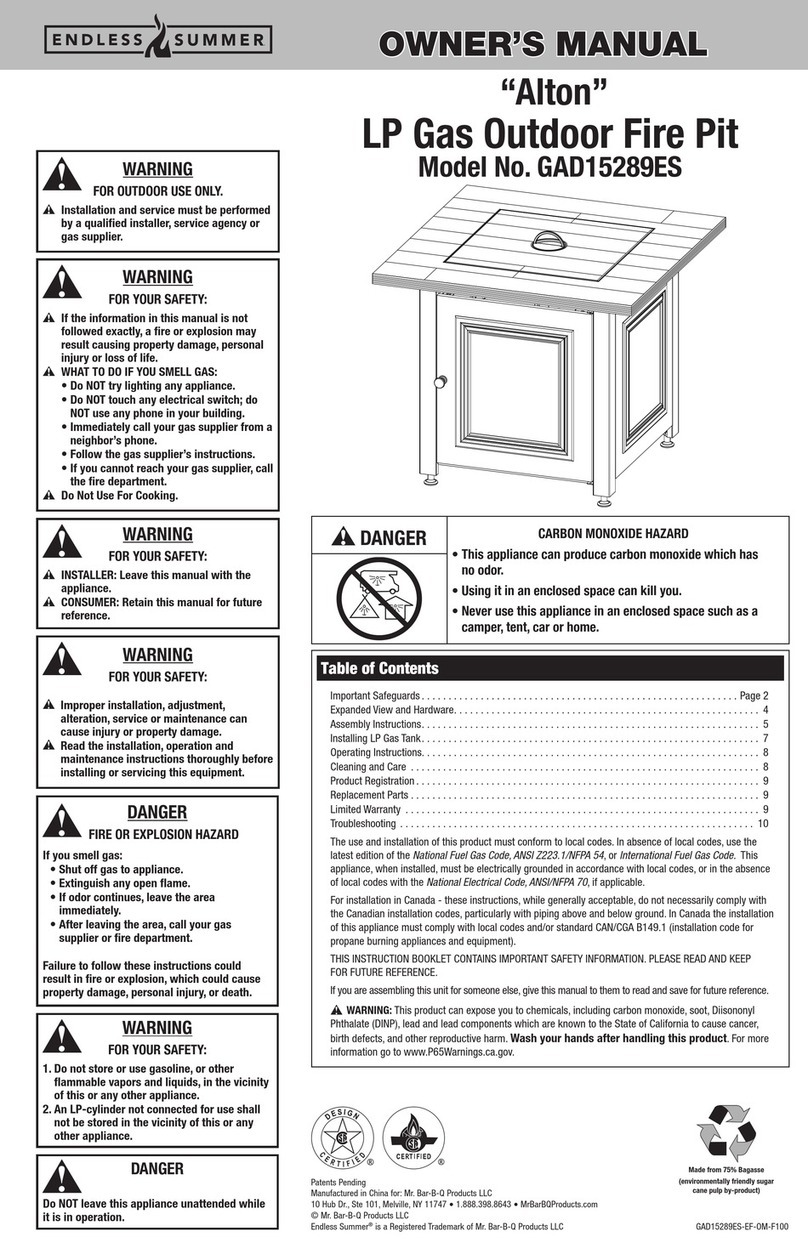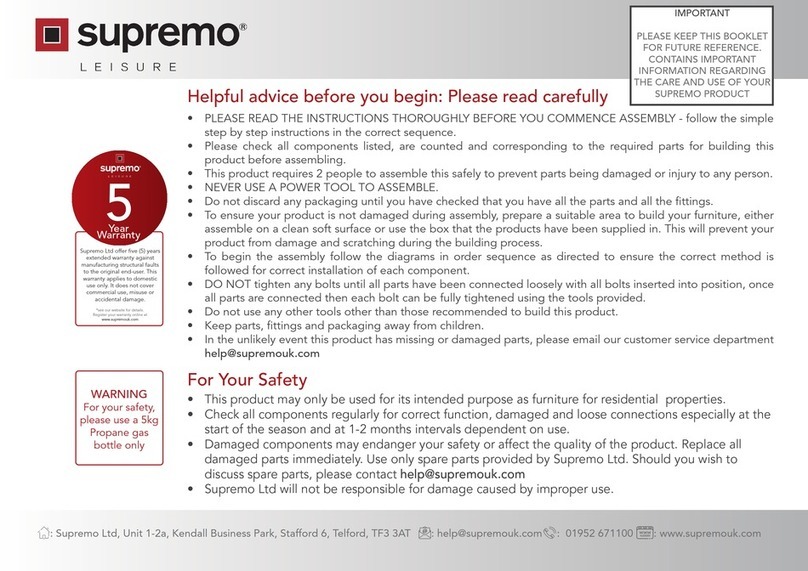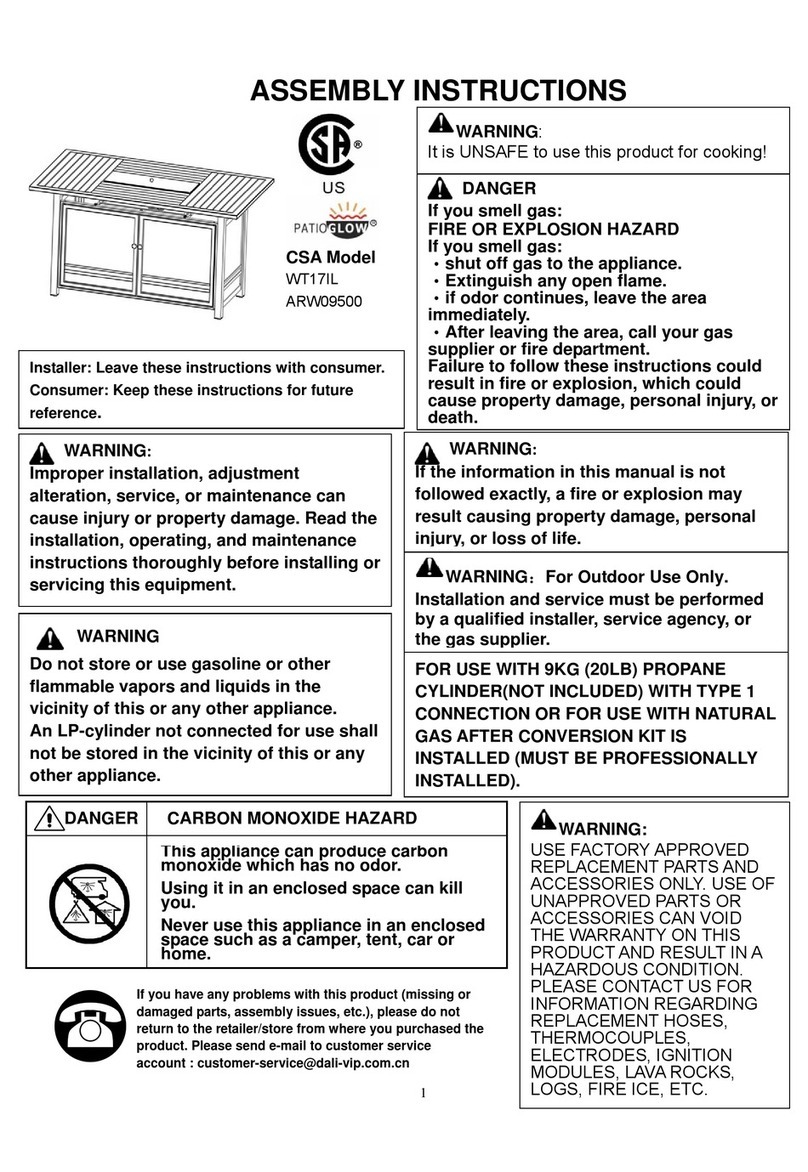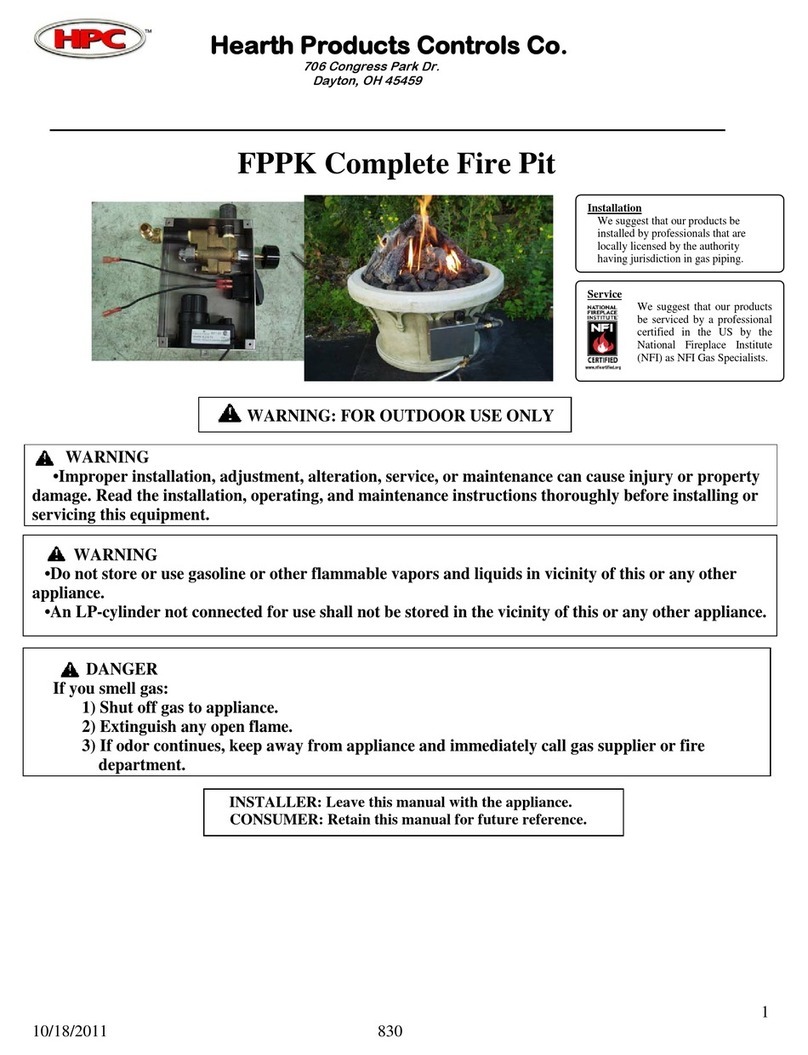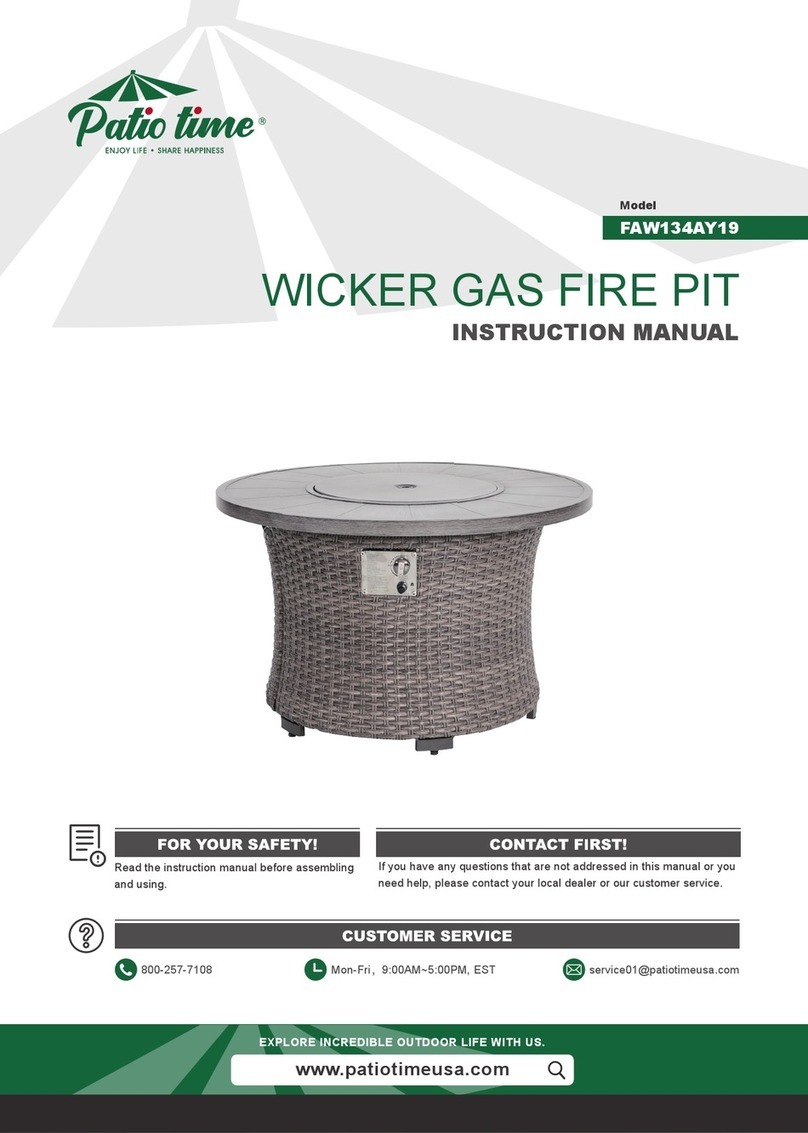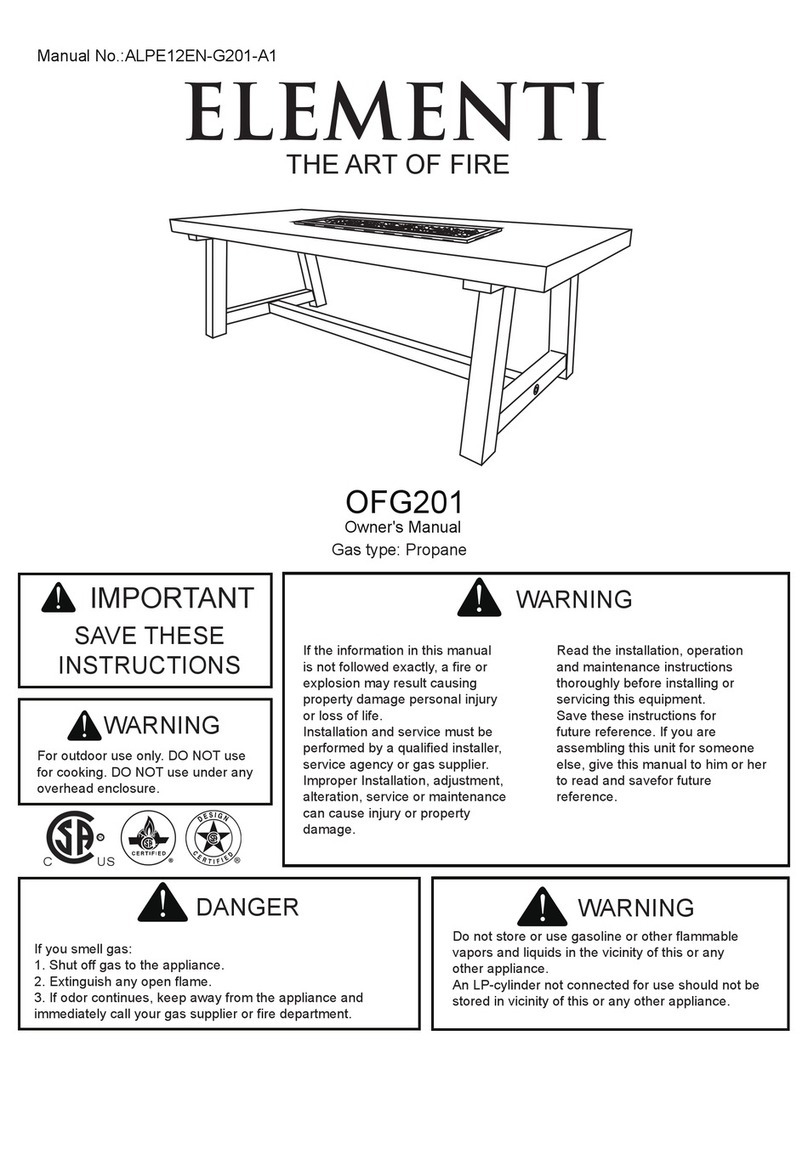BARKER AND STONEHOUSE CARINA User manual

CARINA GAS FIRE PIT - MANUAL
USE OUTDOORS ONLY
CAUTION
DO NOT DISCARD THIS MANUAL
•IMPORTANT OPERATING AND MAINTENANCE INSTRUCTIONS INCLUDED.
•READ, UNDERSTAND AND FOLLOW THESE INSTRUCTIONS FOR SAFE
INSTALLATION AND OPERATION
These instructions are only valid if the following country code is on the appliance. If this code is not
present on the appliance it is necessary to refer to the technical instructions which will provide the
necessary information concerning the modification of the appliance to the condition of use for the
country.

SAFETY INFORMATION
Please read and understand this entire manual before attempting to assemble, operate or install the
product. This appliance has been tested to and complies with the (EU) 2016/426 OutdoorDecorative
Gas Appliances. When connecting to a fixed piping system, the installation must conform to local codes
or the absence of local codes。This manual contains important information about the assembly,
operation and maintenance of this fire pit. Keep this manual for future reference and to educate new
users of this product. This manual should be read in conjunction with the labelingon the product. Safety
precautions are essential when any mechanical or propane fueled equipment is involved. These
precautions are necessary when using, storing, and servicing. Using this equipment with the respect
and caution demanded will reduce the possibilities of personal injury or property damage. The following
symbols shown below are used extensively throughout this manual. Always heed these precautions,
as they are essential when using any mechanical or fueled equipment.
Do not store or use
gasoline, or other flammable
vapors and liquids in the
vicinity of this or any other
appliance. An LP-cylinder
not connected for use shall
not be stored in the vicinity
of this or any other
appliance.
For Outdoor Use Only.
Improper installation,
adjustment, alteration, service
or maintenance can cause
property damage, injury or
death. Read the installation,
operation and maintenance
instructions thoroughly before
installing or servicing this
equipment.
DANGER
DANGER
WARNING
If you smell gas:
●Shut off gas to the appliance.
●Extinguish any open flame.
●If odor continues, keep
away from the appliance and
immediately call your gas
supplier or fire department.
WARNING
DANGER
CARBON MONOXIDE
HAZARD
This appliance can produce
carbon monoxide which has
no odor. Using it in an
enclosed space can kill you.
Never use this appliance in an
enclosed space such as a
camper, tent or home.
WARNING

SAFETY INFORMATION
DANGER
DANGER
DANGER indicates an imminently
hazardous situation which, if not
avoided, will result in death or
serious injury.
Failure to comply with the
precautions and instructions
provided with this fire pit can
result in death, serious bodily
injury and property loss or
damage from hazards of fire,
explosion, burn, asphyxiation,
and/or carbon monoxide
poisoning. Only persons who can
understand and follow the
instructions should use or service
this fire pit.
DANGER
Certain materials or items, when stored under the fire
pit, will be subjected to radiant heat and could be
seriously damaged.
Alert children and adults to the hazards of high surface
temperatures. Stay away from these surfaces to avoid
burning skin or igniting clothing.
Carefully supervise young children when in the vicinity
of the fire pit.
Do not hang clothing or any other flammable materials
from the fire pit, or place on or near the fire pit.
Replace any guard or protective device removed for
servicing the appliance prior to placing back in
service.
Installation and repair should be done by a qualified
service person. The fire pit should be inspected
before use and annually by a qualified service person.
More frequent cleaning may be required as necessary.
It is imperative that the control compartment, burners,
and circulating air passageway of the appliance be
kept clean.
•EXPLOSION - FIRE HAZARD
•Keep solid combustibles,
such as building materials,
paper or cardboard, a safe
distance away from the fire pit
as recommended by the
instructions.
•Provide adequate clearances
around air openings into the
combustion chamber.
•Never use the fire pit in
spaces which do or may
contain volatile or airborne
combustibles, or products
such as gasoline, solvents,
paint thinner, dust particles or
unknown chemicals
•During operation, this
product can be a source of
ignition. Keep fire pit area
clear and free from
combustible materials,
gasoline, paint thinner,
cleaning solvents and other
flammable vapors and liquids.
Do not use fire pit in areas
with high dust content.
Minimum fire pit clearances
from combustible materials:
90cm (36in) from the sides &
90cm (36in) from the rear,
180cm (72in) from ceiling.
•This product is fueled by propane gas. Propane
gas is invisible, odorless, and flammable. An
odorant is normally added to help detect leaks
and can be described as a “rotten egg” smell.
The odorant can fade over time so leaking gas is
not always detectable by smell alone.
•Propane gas is heavier than air and leaking
propane will sink to the lowest level possible. It
can ignite by ignition sources including matches,
lighters, sparks or open flames of any kind many
feet away from the original leak. Use only
propane gas set up for vapor withdrawal.
•Store or use propane gas in compliance with
local ordinances and codes or with ANSI/NFPA
58. Turn off propane when not in use.
WARNING
WARNING

SAFETY INFORMATION
WARNING
We cannot foresee every use which may
be made of our fire pit.
Check with your local fire safety authority
if you have questions about fire pit use.
Other standards govern the use of fuel
gases and heat producing products for
specific uses. Your local authorities can
advise you about these.
Improper installation, adjustment,
alteration, service or maintenance
can cause property damage, injury
or death. Read the installation,
operation and maintenance
instructions thoroughly before
installing or servicing this
equipment.
WARNING
CARBON MONOXIDE HAZARD
This fire pit is a combustion
appliance. All combustion
appliances produce carbon
monoxide (CO) during the
combustion process. This product
is designed to produce extremely
minute, non-hazardous amounts of
CO if used and maintained in
accordance with all warnings and
instructions. Do not block air flow
into or out of the fire pit.
Carbon Monoxide (CO) poisoning
produces flu-like symptoms,
watery eyes, headaches, dizziness,
fatigue and possibly death. You
can't see it and you can't smell it.
It's an invisible killer. If these
symptoms are present during
operation of this product get fresh
air immediately!
For outdoor use only.
Never use inside house, or other
unventilated or enclosed areas.
This fire pit consumes air (oxygen).
Do not use in unventilated or
enclosed areas to avoid
endangering your life.
DANGER
Do not store or use gasoline or other flammable
vapors and liquids in the vicinity of this or any
other appliance. An LP-cylinder not connected for
use shall not be stored in the vicinity of this or
any other appliance.
Never leave fire pit unattended when hot or in
use.
Keep out of reach of children.
DANGER
Don’t burn solid fuels in this
appliance
WARNING
WARNING
HOT! DO NOT TOUCH!
SEVERE BURNS MAY RESULT.
CLOTHING IGNITION MAY RESULT.
Glass and other surfaces are hot
during operation and cool-down.

OPERATION CHECKLIST
Operation Checklist
For a safe and pleasurable heating experience, perform this check before each use.
Before Operating:
1. I am familiar with entire owner’s manual and understand all precautions noted.
2. All components are properly assembled, intact and operable.
3. No alterations have been made.
4. All gas connections are secure and do not leak.
5. Wind velocity is below 10 mph.
6. Unit will operate at reduced efficiency below 40°F/4.44°C
7. Fire pit is outdoors (outside any enclosure).
8. There is adequate fresh air ventilation.
9. Fire pit is away from gasoline or other flammable liquids or vapors.
10. Fire pit is away from windows, air intake openings, sprinklers and other water sources.
11. Fire pit is at least 90cm (36in) on rear and 90cm (36in) on sides from combustible materials.
12. Fire pit is on a hard and level surface.
13. There are no signs of spider or insect nests.
14. All burner passages are clear.
15. All air circulation passages are clear.
16. Children and adults should be alerted to the hazards of high surface temperatures and should stay
away to avoid burns or clothing ignition.
17. Young children should be carefully supervised when they are in the area of the fire pit.
18. Clothing or other protective material should not be hung from the fire pit or placed on or near the
fire pit.
19. Any guard or other protective device removed for servicing the fire pit must be replaced prior
to operating the fire pit.
20. Installation and repair should be done by a qualified service person. The fire pit should be inspected
before use and at least annually by a qualified service person.
21. More frequent cleaning may be required as necessary. It is imperative that the control
compartment, burner and circulating air passageways of the fire pit are kept clean.
22. Do not use this appliance if any part has been under water. Immediately call a qualified service
technician to inspect the appliance and to replace any part of the control system and any gas control
that has been under water.
After Operation
1. Gas control is in OFF position.
2. Gas Tank valve is OFF.
3. Disconnect Gas.
4. After each use, replace cap on tank.
Before installation, ensure that the local distribution conditions (identification of
the type of gas and pressure) and the adjustment of the appliance are compatible

EXPLODED VIEW
ASSEMBLY INSTRUCTIONS
Step 1

Step 2
Step 3
Please use a cylinder no bigger than 500mm (h) by 325 mm (d)
Max Weight 9kg (20lb)

SUPPLIER:
BARKER AND STONEHOUSE
APPLIANCE CODE:
CARINA FIRE PIT
TOTAL HEA INPUT:
14.65KW (1066g/h)
GAS CATEGORY:
I3+(28~30/37)
I3B/P(37)
I3B/P(30)
I3B/P(50)
TYPES OF GAS:
Butane (G30)
Propane (G31)
G30, G31 or their mixtures
GAS PRESSURE:
(28-30) mbar
37mbar
37mbar
(28-30) mbar
50 mbar
GRILL BURNER -INJECTOR SIZE:
1.98mm
1.91mm
1.98mm
1.75mm
P.I.N CODE:
2531CT-0117
SERIE NO:
2018
I3+(28~30/37)
BE, FR, IT, LU, IE, GB, GR, PT, ES, CY, CZ, LT, SK, CH, SI, LV
I3B/P(30)
LU, NL, DK, FI, SE, CY, CZ, EE, LT, MT, SK, SI, BG, IS, NO, TR, HR, RO, IT,
HU, LV
I3B/P(50)
AT, DE, CH, SK, LU
I3B/P(37)
PL
USE OUTDOORS ONLY.
WARNING: ACCESSIBLE PARTS MAY BE VERY HOT. KEEP YOUNG CHILDREN AWAY.
READ THE INSTRUCTIONS BEFORE USING THE APPLIANCE.
This appliance must be installed in accordance with the rules in force and used only in a sufficiently ventilated space.
Consult instructions before installation and use of this appliance
This appliance is intended for decorative purposes
No part of the guard shall be permanently removed
IT DOES NOT GIVE FULL PROTECTION FOR YOUNG CHILDREN, THE ELDERLY OR THE INFIRM.
WARNING: THIS APPLIANCE HAS A NAKED FLAME, A SUITABLE GUARD SHOULD BE USED FOR THE
PROTECTION OF YOUNG CHILDREN, THE ELDERLY AND THE INFIRM.
WARNING
This conversion kit shall be installed by a qualified service agency
in accordance with the manufacturer's instructions and all
applicable codes and requirements of the Authority having
Jurisdiction. If the information in these instructions is not followed
exactly, a fire, explosion or production of carbon monoxide may
result causing property damage, personal injury or loss of life.
The qualified service agency is responsible for the proper
installation of this kit. The installation is not proper and complete
until the operation of the converted appliance is checked as
specified in the manufacturer's instructions supplied with the kit.
2531-18

INSTALLING LP GAS TANK
Connect LP Gas Tank
Before connecting, be sure that there is no debris
caught in the head of the LP gas tank, head of the
regulator valve or in the head of the burner and
burner ports.
Connect regulator/hose assembly to tank by
turning knob clockwise until fully secured into
position.
Disconnect LP Gas Tank
Before disconnecting make sure the LP gas tank
valve is "CLOSED".
Disconnect regulator/hose assembly from LP gas
tank by turning knob counterclockwise until it is loose.
Caution: LP gas tank must be properly disconnected
and removed prior to moving this pit.
This appliance can use with LPG-Propane
Suitable LP gas tank size for this appliance is no bigger than 50mm (h) by 325 mm (d)
Max Weight 9kg (20lb)
LEAK TESTING
WARNING: Before using this outdoor fire pit, make sure you have read, understand and
are following all information provided in the Dangers and Warnings. Failure to follow
those instructions can cause death, serious injury or property damage.
WARNING Never use your fire pit without leak testing all gas connections, hoses and propane tank.
DANGER To prevent fire or explosion hazard:
♦DO NOT smoke or permit ignition sources in the area while conducting a leak test.
♦Perform test OUTDOORS in a well-ventilated area that is protected from the wind.
♦Never perform a leak test with a match or open flame.
♦Never perform a leak test while the fire pit is in use or while the fire pit is still hot.
WHEN TO PERFORM A LEAK TEST:
● After assembling your fire pit and before lighting for the first time, even if purchased fully assembled.
● Every time the LP gas cylinder is refilled, exchanged or if any of the gas components are disconnected or
replaced.
● Any time your fire pit has been moved.
● At least once per year or if your fire pit has not been used for more than 60 days.
CAUTION Strong odors, colds, sinus congestion, etc. May prevent the detection of propane
by smell. Use caution and common sense when testing for leaks.
WARNING: Make sure LP gas tank valve is closed. Close by turning valve clockwise.
Place the LP gas tank upright into the tank tray and secure the tank.
LP GAS

Note: The leak test must be performed in an area that has adequate lighting in order to see if bubbles
are developing and not in a windy or noisy area so larger leaks can be detected by smell or sound.
LIGHTING INSTRUCTIONS
Caution: Keep outdoor gas cooking appliance area clear and free from combustible materials,
gasoline and other flammable vapors and liquids.
Caution: Do not obstruct the flow of combustion and ventilation air.
Caution: Check and clean burner/venturi tubes for insects and insect nests. A clogged tube can lead
to a fire beneath the grill.
Caution: Attempting to light the burner with the lid closed may cause an explosion.
Lighting
1. Read instructions before lighting.
2. Control knob must be in the "OFF" position.
3. Connect propane cylinder securely then open the gas supply.
4. Push and turn control knob counter clockwise to "LOW". Keep holding and depressing the flame
control knob throughout Step 5.
5. Press the IGNITION button and hold for up to 5 seconds to light burner.
6. Release control knob after 4 to 5 seconds after the gas has ignited.
7. If ignition has not occurred return control knob to the off position and repeat steps 4, 5 & 6.
8. If ignition does not occur after the second try, push and turn burner control knob to "OFF" wait 5
minutes, then repeat lighting procedure 2 –7.
9. If igniter does not light burner, use a long match or long butane lighter to ignite the gas whilst the
control knob is turned counter clockwise to low (See part 4 above) keeping the control knob pushed in
for up to 5 seconds after gas is lit.
1. Create a mixture of 50% water and 50% liquid dishwashing soap.
2. Ensure all control knobs are set to the ‘OFF’position.
3. Turn on the gas at the cylinder valve. Turn the cylinder valve knob counter-clockwise until fully
opened. If you hear a rushing sound or smell gas, turn the gas off. Tighten any leaking
connections. If leak is detected at connection nut and tightening does not stop leak, re-inspect
propane tank rubber seal.
4. Apply the soapy water mixture to the following:
A- Supply tank(cylinder) welds. B- Connection nut to tank valve.
C- Back side of connection nut to brass nipple. D- Brass nipple connection into regulator.
E- Regulator connections to gas supply hoses. F- Hose connection to gas manifold.
G- The full length of gas supply hose. H- Tank valve to cylinder.
5. Check each place listed (A-H) for growing bubbles, which indicates a leak. Large leaks may not
be detected by bubbles but, should produce a rushing sound or gas smell.
6. Turn off gas supply at cylinder valve.
7. Turn on control knobs to release gas pressure in hose.
8. Turn control knobs to ‘OFF’position.
9. Tighten any leaking connections. If leak is detected at connection nut and tightening does not
stop leak, re-inspect propane tank rubber seal.
10. Repeat soapy water test until no leaks are detected.
11. Turn off gas supply at cylinder valve until you are ready to use your fire pit.
12. Wash off soapy residue with cold water and towel dry.
CAUTION: Natural Gas leak testing is similar to LP Gas leak testing, the different is you need to
apply the soapy water mixture to the gas supply pipe nipple.

TROUBLESHOOTING
Clean reflector and burner screen
Remove blockage and clean burner
inside and outside
Outdoor temperature is less than 5°C (40°F) and
the tank is less than 1/4 full
Control knob is fully ON and tank is full
Dirt or film on reflector and burner screen
Blockage in burner
Replace propane cylinder
Clear blockage
Turn control knob to ON
Replace propane cylinder
Replace propane cylinder
Check burner and orifices for blockages
PROBLEM
POSSIBLE CAUSE
CORRECTIVE ACTION
Burner will not Ignite
Burner flame is low
Carbon build-up
Thick black smoke
Propane cyliner is empty
Blockage in orifice
Control knob is not in ON position
Gas pressure is low
Minimum clearance: Top: 180cm (72") sides:90cm (36")
Minimum clearance from sides and back of unit to adjacent combustible construction below the
height of the unit, 90cm (36") from the sides and 90cm (36") inches from the back.

CARE AND MAINTENANCE
CAUTION:
All cleaning and maintenance should be done when the fire pit is cold and with the fuel supply disconnected.
1. DO NOT clean any outdoor fire pit part in a self-cleaning oven. The extreme heat will damage the finish.
2. Do not enlarge valve orifices or burner ports when cleaning the valves or burners.
Notices:
1. This outdoor fire pit should be thoroughly cleaned and inspected on a regular basis.
2. Abrasive cleaners will damage this product.
3. Never use oven cleaner to clean any part of outdoor fireplace.
Before Each Use:
1. Keep the outdoor fire pit area clean and free from any combustible materials, gasoline, and other flammable
vapors and liquids.
2. Do not obstruct the flow of the combustion of LP and the ventilation air.
3. Keep the ventilation opening of the LP gas tank area free and clear from debris.
4. Visually check the burner flames to make sure your outdoor fire pit is working properly.
5. See sections below for proper cleaning instructions.
6. Check all gas connections for leaks.
7. Check components for any signs of damage or rust.
8. Check and clean the burner/venturi tubes for insects and insect nests. A clogged tube can lead to a fire
beneath the outdoor fire pit.
9. If damage to any component is detected, do NOT operate until repairs are executed.
Cleaning Surfaces:
1. Wipe surfaces clean with mild dishwashing detergent or baking soda mixed with water.
2. For stubborn surfaces use a citrus based degreaser and a nylon scrubbing brush.
3. Rinse with clean water.
4. Allow to air dry.
Storage:
Between uses:
Turn Control Knob OFF.
Disconnect LP source.
Store fire pit upright in an area sheltered from direct contact with inclement weather (such as
rain, sleet, hail, snow, dust and debris).
If desired, cover fire pit to protect exterior surfaces and to help prevent build-up in air passages.
Note: Wait until fire pit is cold before covering.
During periods of extended inactivity or when transporting:
Turn Control Knob OFF.
Disconnect LP source and move to a secure, well-ventilated location outdoors.
Store fire pit upright in an area sheltered from direct contact with inclement weather (such as rain, sleet,
hail and snow) as well as dust and debris.
If desired, cover fire pit to protect exterior surfaces and to help prevent build-up in air passages. Never
leave LP cylinder exposed to direct sunlight or excessive heat.
Note: Wait until fire pit is cold before covering.
Before each use of appliance, inspect the hose and make sure to properly locate the gas. Always inspect the
hose for evidence of excessive abrasion, cuts or wear prior to use and make sure to perform the leak test.
The hose assembly must be replaced prior to the appliance being put into operation if there is evidence of
excessive abrasion, wear or if the hose is damaged. The replacement hose assembly shall be that specified
by the manufacturer.
Table of contents
